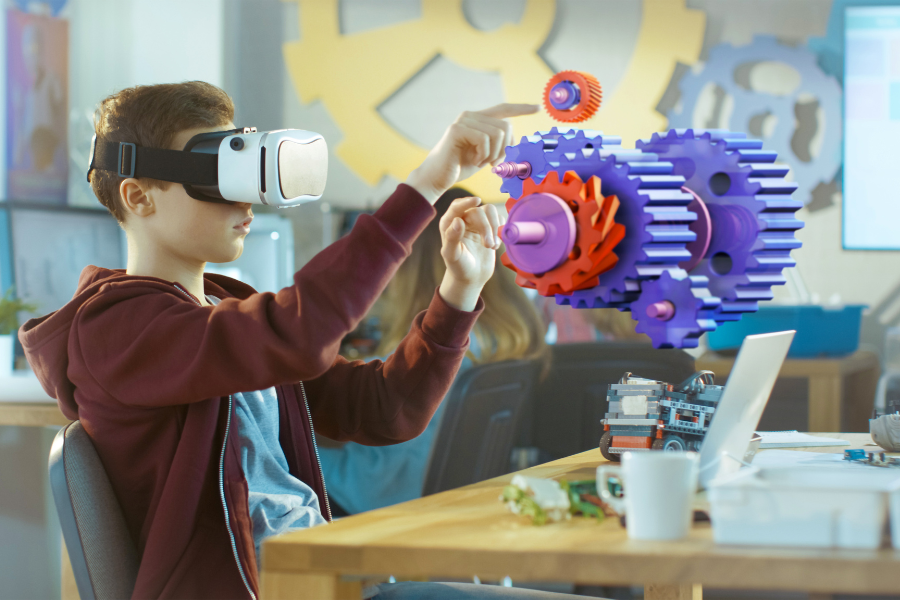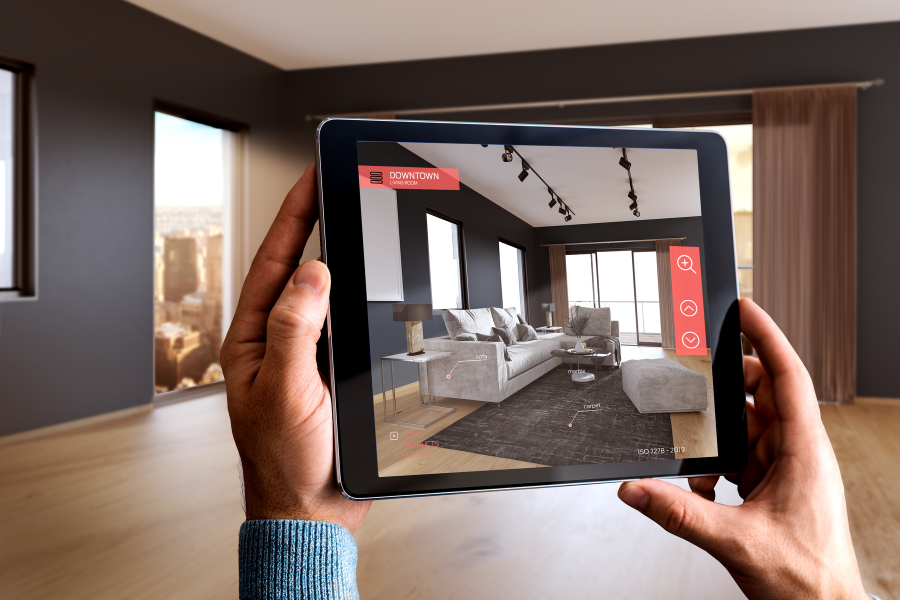HOT OFFER! Save $180 on selected internet plans + get beIN SPORTS CONNECT included!...Use promo code BEIN30 at checkout! Hurry, limited time only!
Augmented reality vs. virtual reality: What’s the difference?
Entertainment & Internet Blog | MATE | 30 November 2023

The tech landscape has changed drastically over the past few years, especially when it comes to simulated reality. We’re talking about augmented reality (AR) and virtual reality (VR). These groundbreaking technologies are reshaping how we interact with both the digital and physical worlds, providing immersive experiences that were once the stuff of science fiction.
But while VR and AR technology have existed in mainstream applications for some time now, there’s still a little bit of confusion around what these terms mean and the difference between AR and VR. We’re here to explain the fundamentals of these technologies, investigate the differences between them, and provide you with some real-world examples of VR and AR.
Understanding the basics: AR vs. VR
AR and VR are both examples of a simulated reality. But what are the key differences between the two?
Augmented reality is about enhancing our perception of the real world by overlaying digital elements—whether that’s images, sounds, or even tactile feedback. We can also refer to this as mixed reality or extended reality since it merges our real-life environment with the virtual by adding digital elements. On the other hand, virtual reality transports users into a completely virtual environment, essentially detaching them from the physical world. The primary distinction between AR and VR lies in their interaction with reality: AR enhances it, while VR creates an entirely new one.
What is augmented reality?
Leveraging advanced technology, augmented reality superimposes digital information and virtual elements onto our physical environment, creating a fusion of the digital world and the physical world.
At the heart of AR is the need for real-time data processing. Cameras and sensors scan the environment, and the data is then processed to overlay relevant digital elements seamlessly. This requires a blend of computer vision, data analytics, and graphics rendering—all of which come together to create the augmented reality experience.
As AR continues to evolve, its potential applications are only limited by our imagination. From gaming and entertainment to industrial design and beyond, AR is set to redefine everyday life and our interactions with the world around us.
10 Real-life examples of AR technology:
- Mobile Phone AR games: Games like “Pokémon Go” and “Harry Potter: Wizards Unite” overlay digital creatures and items onto the real world using your smartphone’s camera.
- Snapchat and Instagram filters: These social media platforms use AR to overlay digital masks, effects, and animations onto users’ faces or surroundings.
- Furniture placement apps: IKEA’s “Place” app lets users virtually place furniture in their homes to see how it looks and fits before buying.
- Interactive learning: Educational apps that overlay information or animations on physical objects, like books or posters, to enhance learning.
- Virtual try-Ons: Retail apps that allow users to virtually try on clothes, shoes, makeup, or even hairstyles to see how they look.
- AR in museums: Some museums offer AR experiences where visitors can point their devices at exhibits to get additional information, animations, or historical context.
- Navigation apps: AR navigation apps overlay directional arrows and instructions onto the real world, helping users navigate streets and landmarks.
- Medical training: AR apps that overlay digital information on medical mannequins, helping students learn anatomy and procedures.
- Shopping assistants: In-store AR experiences where customers can get product details, reviews, and price comparisons by pointing their device at a product.
- Interactive marketing campaigns: Brands using AR for interactive print ads, posters, or even product packaging, offering an immersive experience to consumers.
What is virtual reality?
With virtual reality, you become completely immersed in a digital world or virtual environment where you can interact with your surroundings in real time. This is achieved through a virtual reality headset, which creates a panoramic 3D virtual world that responds to your movements.
The technology behind VR is a blend of computer graphics, sound engineering, and sensory feedback. Advanced algorithms make sure that the virtual environment reacts in real time to user inputs, making the experience super immersive for VR users. And while many associate VR primarily with gaming—where players can explore vast landscapes, embark on quests, battle waves of enemies, or compete in lifelike scenarios—it has applications that go well beyond entertainment.
10 Real-life examples of VR technology:
- VR gaming: Games like“Beat Saber,” “Half-Life: Alyx,” and“The Elder Scrolls V: Skyrim VR” provide immersive experiences where players interact with a fully virtual environment using VR headsets and controllers.
- Virtual tourism: Apps like “Google Earth VR” allow users to virtually explore locations around the world, from famous landmarks to remote landscapes.
- Medical training: We mentioned above that AR can be used in medical training. But VR simulations can take this a step further, where medical students can practise surgeries and procedures in a risk-free environment.
- Virtual concerts and events: Attendees can experience live concerts, theatre performances, or other events from the comfort of their homes.
- Education and training: Virtual classrooms and training simulations across various industries, from firefighting to machinery operation.
- Virtual social interaction: Platforms like “VRChat” and “AltspaceVR” where users can interact, socialise, and attend events in virtual spaces.
- Architectural visualisation: Architects and designers can create virtual models of their designs, allowing clients to experience spaces before they’re built.
- Cinematic VR: Immersive movies and documentaries where viewers can look around and feel like they’re part of the story.
- Rehabilitation: Using VR for physical therapy and rehabilitation, allowing patients to practise movements and exercises in virtual spaces.
- Flight and driving simulations: Training pilots and drivers in realistic virtual environments before they operate real vehicles.
Augmented reality vs. virtual reality: The key differences
When it comes to augmented reality vs virtual reality, the distinctions might seem subtle but are very different in terms of experience and application. At its core, AR overlays digital content onto the real world, enhancing our current reality. In contrast, VR immerses users entirely in a virtual environment, detaching them from the physical world.
- Hardware: AR often requires devices like smartphones or augmented reality glasses, which superimpose graphics onto real-world views. VR, on the other hand, typically demands more complex equipment like specialised VR devices or headsets and sometimes hand controllers or gloves to interact with your environment inside the virtual world.
- User experience: AR adds to the reality you would ordinarily see rather than replacing it completely. Think of apps that let you visualise furniture in your room before buying. VR, on the other hand, replaces your world with a new one (through the use of a headset), like a game where you’re battling dragons or exploring alien landscapes.
- Real-world application: AR has found significant utility in fields like retail, navigation, and even industrial design. VR shines in sectors like gaming, training simulations, and therapeutic interventions.
Real-world applications and impacts of AR and VR
Both AR and VR are making significant strides in real-world scenarios, revolutionising how we learn, work, and play.
Augmented reality vs. virtual reality: Healthcare
In the healthcare sector, both AR and VR are making significant strides. Surgeons are increasingly relying on AR to overlay digital images and data on the human body, ensuring greater precision during intricate procedures. This real-time information can be a game-changer, especially in complex surgeries.
When it comes to VR, this is proving to be a huge benefit for patient rehabilitation and therapy. Patients recovering from traumatic experiences or physical injuries can undergo VR-assisted therapy, providing them with controlled environments to confront fears or practise physical movements safely.
Augmented reality vs. virtual reality: Education
Education is undergoing a transformation with the integration of AR and VR. AR is being utilised to create interactive learning modules, turning abstract concepts into tangible experiences.
VR, meanwhile, is breaking down classroom walls: virtual field trips facilitated by VR are becoming popular, allowing students to traverse ancient ruins, dive deep into the ocean, or even walk on Mars, all while staying within the safe confines of their classroom.

Augmented reality vs. virtual reality: Gaming
The entertainment sector has been quick to adopt both AR and VR. AR games, with “Pokémon Go” being one of the most famous and popular examples, have revolutionised mobile gaming. Utilising a smart device (usually a phone or tablet), players can venture into the real world and use their device to see virtual objects, digital creatures or objectives overlaid on their surroundings.
On the other hand, VR gaming takes immersion to the next level. By wearing a specialised VR headset, players can step into a lifelike world where they can battle enemies or solve puzzles. Beyond gaming, VR is also being used to offer virtual seats at concerts, theatre performances, or even movie premieres, providing fans with front-row experiences from the comfort of their homes.
Augmented reality vs. virtual reality: Infrastructure
When it comes to infrastructure, design, and architecture, AR and VR are invaluable tools. AR assists professionals in visualising projects within real-world settings. For instance, an architect might use AR to project a building design onto a vacant plot, allowing stakeholders to see how it fits within its surroundings.
VR, in contrast, offers an even deeper dive. Clients can wear VR headsets to take virtual tours of homes, offices, or public spaces, experiencing them in full 3D before a single brick is laid. This not only aids in design decisions but also helps in marketing properties or spaces to potential buyers or investors.
The future of simulated realities
As technology continues to evolve, the sky’s the limit for AR and VR. As it continues to advance, it’s likely we’ll see a convergence of the two, blurring the lines between the physical world and the virtual world. This fusion could give us some interesting and exciting things to look forward to in the future—from more immersive experiences that reshape the way we consume entertainment to the way we learn, and even the way we interact with other people.
Beyond gaming and professional applications, imagine virtual holidays or AR-enhanced daily routines. The societal impacts are massive, from revolutionising job training to creating new forms of art and storytelling. One thing’s for sure: the future of AR and VR technology will only be limited by what we can imagine.
MATE: Helping you stay connected
In the tech age of AR and VR, having a reliable and fast internet connection is a modern necessity. Whether you’re diving into a VR game or enhancing your world with AR, MATE makes sure you can do it without a hitch.
But it’s not just about speed. Choosing MATE means first class customer service, transparent pricing, and the peace of mind that comes with partnering with a leading Aussie Telco. As the digital landscape evolves, trust MATE to keep you seamlessly connected.
Check our MATE’s 4G and 5G mobile plans to keep you connected. And don’t forget—you can automatically save $10 per month when you bundle a MATE mobile plan with any of our nbn home internet plans.
MATE 4G mobile plans
- Good Mates: A good choice for those who only use their mobile data for basic tasks.
- Better Mates: Great for anyone who uses their mobile data for all the basics, plus video calls, music streaming and video streaming.
MATE 5G mobile plans
- Great Mates: There is plenty of data with this 5G plan, perfect for those who are often without a Wi-Fi connection.
- Best Mates: Top choice for those who like to stream their favourite movies and TV shows while on the go.
- Soul Mates: The ultimate 5G plan. Stream, download and upload with a massive data allowance every month.

